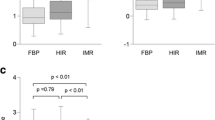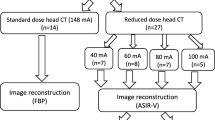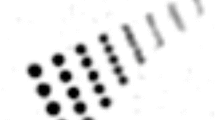Abstract
Background
Iterative reconstruction has become the standard method for reconstructing computed tomography (CT) scans and needs to be verified for adaptation.
Objective
To assess the image quality after adapting advanced modeled iterative reconstruction (ADMIRE) for pediatric head CT.
Materials and methods
We included image sets with filtered back projection reconstruction (the cFBP group, n=105) and both filtered back projection and ADMIRE reconstruction (the lower-dose group, n=109) after dose reduction. All five strength levels of ADMIRE and filtered back projection were adapted for the lower-dose group and compared with the cFBP group. Quantitative parameters including noise, signal-to-noise ratio and contrast-to-noise ratio and qualitative parameters including noise, white matter and gray matter differentiation of the supra- and infratentorial levels, sharpness, artifact, and diagnostic accuracy were also evaluated and compared with interobserver agreement.
Results
There was a mean dose reduction of 30.6% in CT dose index volume, 32.1% in dose length product, and 32.1% in effective dose after tube current reduction. There was gradual reduction of noise in air, cerebrospinal fluid and white matter with strength levels of ADMIRE from 1 to 5 (P<0.001). Signal-to-noise ratio and contrast-to-noise ratio in all age groups increased among strength levels of ADMIRE, in sequence from 1 to 5, with statistical significance (P<0.001). Gradual reduction of qualitative parameters was noted among strength levels of ADMIRE in sequence from 1 to 5 (P<0.001).
Conclusion
Use of ADMIRE for pediatric head CT can reduce radiation dose without degrading image quality.

Similar content being viewed by others
References
McKnight CD, Watcharotone K, Ibrahim M et al (2014) Adaptive statistical iterative reconstruction: reducing dose while preserving image quality in the pediatric head CT examination. Pediatr Radiol 44:997–1003
Brenner DJ, Hall EJ (2007) Computed tomography--an increasing source of radiation exposure. N Engl J Med 357:2277–2284
Solomon J, Mileto A, Ramirez-Giraldo JC, Samei E (2015) Diagnostic performance of an advanced modeled iterative reconstruction algorithm for low-contrast detectability with a third-generation dual-source multidetector CT scanner: potential for radiation dose reduction in a multireader study. Radiology 275:735–745
Beister M, Kolditz D, Kalender WA (2012) Iterative reconstruction methods in X-ray CT. Phys Med 28:94–108
Ramirez-Giraldo J, Grant K, Schmidt B, Fuld MK (2014) Radiation dose optimization technologies in multidetector computed tomography: a review. Medical Physics 2:420–430
The 2007 recommendations of the International 456 Commission on Radiological Protection. ICRP publication 103. 457 Ann ICRP 37:1–332
Deak PD, Smal Y, Kalender WA (2010) Multisection CT protocols: sex- and age-specific conversion factors used to determine effective dose from dose-length product. Radiology 257:158–166
Kilic K, Erbas G, Guryildirim M et al (2013) Quantitative and qualitative comparison of standard-dose and low-dose pediatric head computed tomography: a retrospective study assessing the effect of adaptive statistical iterative reconstruction. J Comput Assist Tomogr 37:377–381
Mullins ME, Lev MH, Bove P et al (2004) Comparison of image quality between conventional and low-dose nonenhanced head CT. AJNR Am J Neuroradiol 25:533–538
Kilic K, Erbas G, Guryildirim M et al (2011) Lowering the dose in head CT using adaptive statistical iterative reconstruction. AJNR Am J Neuroradiol 32:1578–1582
Korn A, Fenchel M, Bender B et al (2012) Iterative reconstruction in head CT: image quality of routine and low-dose protocols in comparison with standard filtered back-projection. AJNR Am J Neuroradiol 33:218–224
Rivers-Bowerman MD, Shankar JJ (2014) Iterative reconstruction for head CT: effects on radiation dose and image quality. Can J Neurol Sci 41:620–625
Ono S, Niwa T, Yanagimachi N et al (2016) Improved image quality of helical computed tomography of the head in children by iterative reconstruction. J Neuroradiol 43:31–36
Simon B, Letourneau P, Vitorino E, McCall J (2001) Pediatric minor head trauma: indications for computed tomographic scanning revisited. J Trauma 51:231–237
Rompel O, Glockler M, Janka R et al (2016) Third-generation dual-source 70-kVp chest CT angiography with advanced iterative reconstruction in young children: image quality and radiation dose reduction. Pediatr Radiol 46:462–472
Linet MS, Kim KP, Rajaraman P (2009) Children’s exposure to diagnostic medical radiation and cancer risk: epidemiologic and dosimetric considerations. Pediatr Radiol 39:S4–S26
Khawaja RD, Singh S, Otrakji A et al (2015) Dose reduction in pediatric abdominal CT: use of iterative reconstruction techniques across different CT platforms. Pediatr Radiol 45:1046–1055
Goske MJ, Applegate KE, Boylan J et al (2008) The ‘Image Gently’ campaign: increasing CT radiation dose awareness through a national education and awareness program. Pediatr Radiol 38:265–269
Geyer LL, Schoepf UJ, Meinel FG et al (2015) State of the art: iterative CT reconstruction techniques. Radiology 276:339–357
Chen B, Ramirez Giraldo JC, Solomon J, Samei E (2014) Evaluating iterative reconstruction performance in computed tomography. Med Phys 41:121913
Ho C, Oberle R, Wu I, Kim E (2014) Comparison of image quality in pediatric head computed tomography reconstructed using blended iterative reconstruction versus filtered back projection. Clin Imaging 38:231–235
Patino M, Fuentes JM, Singh S et al (2015) Iterative reconstruction techniques in abdominopelvic CT: technical concepts and clinical implementation. AJR Am J Roentgenol 205:W19–W31
Mirro AE, Brady SL, Kaufman RA (2016) Full dose-reduction potential of dtatistical iterative reconstruction for head CT protocols in a predominantly pediatric population. AJNR Am J Neuroradiol 37:1199–1205
Schaller F, Sedlmair M, Raupach R et al (2016) Noise reduction in abdominal computed tomography applying iterative reconstruction (ADMIRE). Acad Radiol 23:1230–1238
Scholtz JE, Kaup M, Husers K et al (2016) Advanced modeled iterative reconstruction in low-tube-voltage contrast-enhanced neck CT: evaluation of objective and subjective image quality. AJNR Am J Neuroradiol 37:143–150
Kim HG, Lee HJ, Lee SK et al (2017) Head CT: image quality improvement with ASIR-V using a reduced radiation dose protocol for children. Eur Radiol 27:3609–3617
Nam SB, Jeong DW, Choo KS et al (2017) Image quality of CT angiography in young children with congenital heart disease: a comparison between the sinogram-affirmed iterative reconstruction (SAFIRE) and advanced modelled iterative reconstruction (ADMIRE) algorithms. Clin Radiol 72:1060–1065
Sagara Y, Hara AK, Pavlicek W et al (2010) Abdominal CT: comparison of low-dose CT with adaptive statistical iterative reconstruction and routine-dose CT with filtered back projection in 53 patients. AJR Am J Roentgenol 195:713–719
Singh S, Kalra MK, Hsieh J et al (2010) Abdominal CT: comparison of adaptive statistical iterative and filtered back projection reconstruction techniques. Radiology 257:373–383
Chang W, Lee JM, Lee K et al (2013) Assessment of a model-based, iterative reconstruction algorithm (MBIR) regarding image quality and dose reduction in liver computed tomography. Investig Radiol 48:598–606
Qiu D, Seeram E (2016) Does iterative reconstruction improve image quality and reduce dose in computed tomography? Radiol Open J 1:42–54
Clinthorne NH, Pan TS, Chiao PC et al (1993) Preconditioning methods for improved convergence rates in iterative reconstructions. IEEE Trans Med Imaging 12:78–83
Dalehaug I, Bolstad KN, Aadnevik D et al (2017) ADMIRE vs. SAFIRE: Objective comparison of CT reconstruction algorithms and their noise properties. arXiv preprint arXiv: 1708.09616, 2017. [Online]. Available: https://arxiv.org/abs/1708.09616
Moscariello A, Takx RA, Schoepf UJ et al (2011) Coronary CT angiography: image quality, diagnostic accuracy, and potential for radiation dose reduction using a novel iterative image reconstruction technique-comparison with traditional filtered back projection. Eur Radiol 21:2130–2138
Gordic S, Desbiolles L, Stolzmann P et al (2014) Advanced modelled iterative reconstruction for abdominal CT: qualitative and quantitative evaluation. Clin Radiol 69:e497–e504
Vardhanabhuti V, Riordan RD, Mitchell GR et al (2014) Image comparative assessment using iterative reconstructions: clinical comparison of low-dose abdominal/pelvic computed tomography between adaptive statistical, model-based iterative reconstructions and traditional filtered back projection in 65 patients. Investig Radiol 49:209–216
Deak Z, Grimm JM, Treitl M et al (2013) Filtered back projection, adaptive statistical iterative reconstruction, and a model-based iterative reconstruction in abdominal CT: an experimental clinical study. Radiology 266:197–206
Ellmann S, Kammerer F, Allmendinger T et al (2018) Advanced modeled iterative reconstruction (ADMIRE) facilitates radiation dose reduction in abdominal CT. Acad Radiol 25:1277–1284
Kaul D, Kahn J, Huizing L et al (2016) Dose reduction in paediatric cranial CT via iterative reconstruction: a clinical study in 78 patients. Clin Radiol 71:1168–1177
Vorona GA, Zuccoli G, Sutcavage T et al (2013) The use of adaptive statistical iterative reconstruction in pediatric head CT: a feasibility study. AJNR Am J Neuroradiol 34:205–211
Hwang JY, Do KH, Yang DH et al (2015) A survey of pediatric CT protocols and radiation doses in south Korean hospitals to optimize the radiation dose for pediatric CT scanning. Medicine (Baltimore) 94:e2146
Author information
Authors and Affiliations
Corresponding author
Ethics declarations
Conflicts of interest
None
Additional information
Publisher’s note
Springer Nature remains neutral with regard to jurisdictional claims in published maps and institutional affiliations.
Rights and permissions
About this article
Cite this article
Cho, HH., Lee, S.M. & You, S.K. Pediatric head computed tomography with advanced modeled iterative reconstruction: focus on image quality and reduction of radiation dose. Pediatr Radiol 50, 242–251 (2020). https://doi.org/10.1007/s00247-019-04532-z
Received:
Revised:
Accepted:
Published:
Issue Date:
DOI: https://doi.org/10.1007/s00247-019-04532-z




